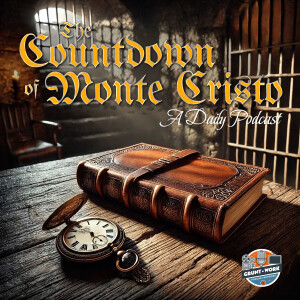
Tuesday Apr 29, 2025
Corridors of No Return (The Count of Monte Cristo, Chapter 8)
📚 Summary:
Edmond Dantès is led from the Palais de Justice into the prison system—physically and metaphorically crossing the threshold from freedom into oppression. Accompanied by armed gendarmes, he walks through cold, winding corridors that sap his courage and end at an iron door that slams shut behind him. Though Villefort’s promises still echo in his ears, darkness and silence press in. Hours later, a glimmer of hope returns when footsteps approach—but what feels like release is only another stage in his descent. With calm trust in the justice system, Dantès enters a carriage, unaware he’s being delivered not to liberation, but to the feared Château d’If.
✨ What Happens:
•Dantès is flanked by gendarmes and taken through the shadowy interior of the Palais de Justice.
•He is locked in a barred, mephitic cell, but maintains hope that Villefort is working for his release.
•As darkness falls, he jumps at every sound, thinking it signals freedom.
•At last, a group of torch-bearing guards arrives.
•Believing Villefort has sent for him, Dantès calmly enters a carriage—unaware it will take him deeper into imprisonment.
💡 Thoughts & Reflections:
•Corridors as Symbol: The winding path from court to cell echoes a descent into powerlessness and invisibility.
•False Hope: Dantès’ trust in Villefort shows how easily hope can become a tool of control.
•The Theater of Authority: The door slams, the sabres glitter, the torches flare—every detail contributes to the overwhelming force of the state.
•Psychological Isolation: Darkness becomes a character in itself, tightening Dantès’ internal spiral toward despair.
📖 Historical & Cultural Context:
•Château d’If: A real island fortress used to isolate political prisoners. Its inaccessibility made it ideal for silencing dissent.
•Palais de Justice: The Marseille courthouse really did link to prison chambers, adding realism to Dumas’ narrative.
•Accoules Clocktower: A historic visual marker—used here to emphasize how close Dantès remains to the outside world, even as it slips away.
•Restoration-Era Justice: Trials of suspected Bonapartists often took place in secret or with little due process. Dantès is experiencing this system firsthand.
🔮 Foreshadowing:
•The Door that Closes: The iron door becomes a symbol of irrevocable change—once it shuts, Dantès is no longer the man he was.
•Illusions of Rescue: The final carriage ride sets up the devastating reveal to come: that this is not a journey toward freedom but to the Château d’If.
•Emotional Inversion: Hope will soon turn to fury—this is the moment when Dantès’ innocence begins to erode under institutional cruelty.
📢 Support the Show:
If you’re captivated by how Dumas builds suspense and symbolism, support the show on Patreon! Get bonus episodes, behind-the-scenes reflections, and full-length audio readings at patreon.com/gruntworkpod 📖✨
🔍 SEO Keywords: The Count of Monte Cristo podcast, Château d’If, Edmond Dantès imprisonment, Villefort betrayal, classic literature analysis, Bourbon Restoration justice, Alexandre Dumas podcast.
No comments yet. Be the first to say something!